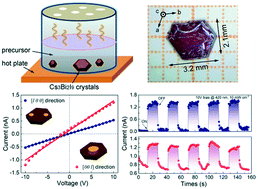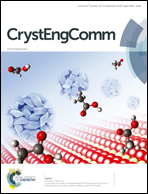Lead free halide perovskite Cs3Bi2I9 bulk crystals grown by a low temperature solution method
Abstract
As a member of the bismuth iodide family compounds, Cs3Bi2I9 perovskite shows potential applications in photovoltaic devices and radiation detectors, due to the absence of toxic lead and its high air and moisture stability. In this work, we report Cs3Bi2I9 bulk crystals grown by a low temperature solvent volatilized crystallization method. The morphology of the single crystals exhibits a well symmetric hexagonal shape, with a layered structure along the [00l] direction. Three defect related transitions (iodine substituting bismuth (IBi) to the valence band maximum (VBM), the conduction band minimum (CBM) to caesium substituting bismuth (CsBi1−/2−), and the CBM to caesium substituting iodine (CsI1+/2+)) are identified in 10 K photoluminescence spectra, with dissociation energies of 47.87 meV, 45.28 meV, and 52.01 meV, respectively. The anisotropic resistivities along the [00l] and [l00] directions are compared, with values of 11.08 GΩ cm and 0.77 GΩ cm, respectively, which is attributed to the difference of carrier mobility. This is further certified by the first principles calculations, which demonstrate that the effective masses along the [00l] and [l00] directions are 3.22me (electrons)/2.14me (holes) and 0.327me (electrons)/0.946me (holes), respectively. The Cs3Bi2I9 device exhibits fast photoresponse to optical light, with an on–off ratio of ∼24 along [l00], which is fifteen times higher than that along [00l]. This photoelectric anisotropy dictates the potential applications in photovoltaic devices and radiation detectors.



 Please wait while we load your content...
Please wait while we load your content...